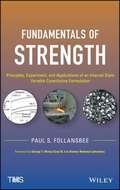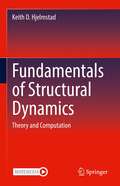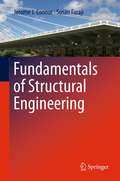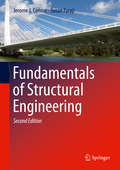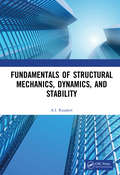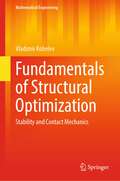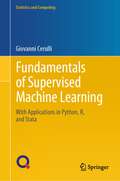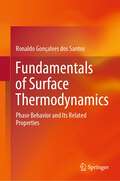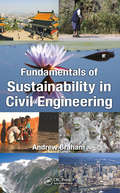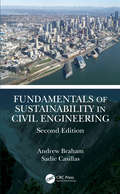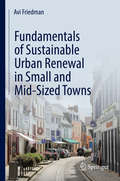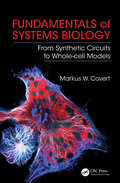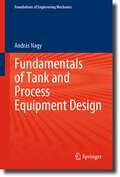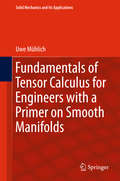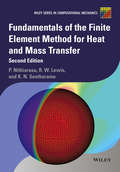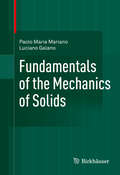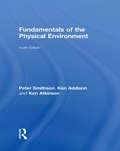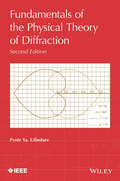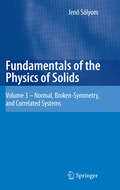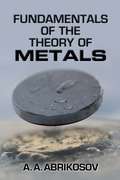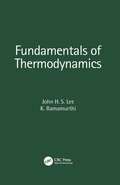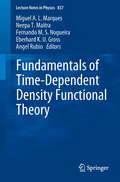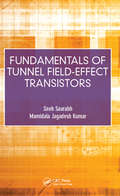- Table View
- List View
Fundamentals of Strength: Principles, Experiment, and Applications of an Internal State Variable Constitutive Formulation
by George T. Gray III Paul S. FollansbeeOffers data, examples, and applications supporting the use of the mechanical threshold stress (MTS) model Written by Paul S. Follansbee, an international authority in the field, this book explores the underlying theory, mechanistic basis, and implementation of the mechanical threshold stress (MTS) model. Readers are introduced to such key topics as mechanical testing, crystal structure, thermodynamics, dislocation motion, dislocation-obstacle interactions, hardening through dislocation accumulation, and deformation kinetics. The models described in this book support the emerging theme of Integrated Computational Materials Engineering (ICME) by offering a foundation for the bridge between length scales characterizing the mesoscale (mechanistic) and the macroscopic. Fundamentals of Strength begins with a chapter that introduces various approaches to measuring the strength of metals. Next, it covers: Structure and bonding Contributions to strength Dislocation-obstacle interactions Constitutive law for metal deformation Further MTS model developments Data analysis: deriving MTS model parameters The next group of chapters examines the application of the MTS model to copper and nickel, BCC metals and alloys, HCP metals and alloys, austenitic stainless steels, and heavily deformed metals. The final chapter offers suggestions for the continued development and application of the MTS model. To help readers fully understand the application of the MTS model, the author presents two fictional materials along with extensive data sets. In addition, end-of-chapter exercises give readers the opportunity to apply the models themselves using a variety of data sets. Appropriate for both students and materials researchers, Fundamentals of Strength goes beyond theory, offering readers a model that is fully supported with examples and applications.
Fundamentals of Structural Dynamics: Theory and Computation
by Keith D. HjelmstadThis text closes the gap between traditional textbooks on structural dynamics and how structural dynamics is practiced in a world driven by commercial software, where performance-based design is increasingly important. The book emphasizes numerical methods, nonlinear response of structures, and the analysis of continuous systems (e.g., wave propagation). Fundamentals of Structural Dynamics: Theory and Computation builds the theory of structural dynamics from simple single-degree-of-freedom systems through complex nonlinear beams and frames in a consistent theoretical context supported by an extensive set of MATLAB codes that not only illustrate and support the principles, but provide powerful tools for exploration. The book is designed for students learning structural dynamics for the first time but also serves as a reference for professionals throughout their careers.
Fundamentals of Structural Engineering
by Jerome J. Connor Susan FarajiFundamentals of Structural Engineering provides a balanced, seamless treatment of both classic, analytic methods and contemporary, computer-based techniques for conceptualizing and designing a structure. The book?s principle goal is to foster an intuitive understanding of structural behavior based on problem solving experience for students of civil engineering and architecture who have been exposed to the basic concepts of engineering mechanics and mechanics of materials. Distinct from many undergraduate textbooks, which are focused mainly on either teaching manual analysis methods and applying them to simple, idealized structures or reformulating structural analysis methods in terms of matrix notation, this text instead encourages the student to develop intuition about structural behavior. The authors of this text recognize the notion that engineers reason about behavior using simple models and intuition they acquire through problem solving. The approach adopted in this text develops this type of intuition by presenting extensive, realistic problems and case studies together with computer simulation, which allows rapid exploration of how a structure responds to changes in geometry and physical parameters.
Fundamentals of Structural Engineering
by Susan Faraji Jerome J. ConnorFundamentals of Structural Engineering provides a balanced, seamless treatment of both classic, analytic methods and contemporary, computer-based techniques for conceptualizing and designing a structure. The book?s principle goal is to foster an intuitive understanding of structural behavior based on problem solving experience for students of civil engineering and architecture who have been exposed to the basic concepts of engineering mechanics and mechanics of materials. Distinct from many undergraduate textbooks, which are focused mainly on either teaching manual analysis methods and applying them to simple, idealized structures or reformulating structural analysis methods in terms of matrix notation, this text instead encourages the student to develop intuition about structural behavior. The authors of this text recognize the notion that engineers reason about behavior using simple models and intuition they acquire through problem solving. The approach adopted in this text develops this type of intuition by presenting extensive, realistic problems and case studies together with computer simulation, which allows rapid exploration of how a structure responds to changes in geometry and physical parameters.
Fundamentals of Structural Mechanics, Dynamics, and Stability
by A.I. RusakovFundamentals of Structural Mechanics, Dynamics, and Stability examines structural mechanics from a foundational point of view and allows students to use logical inference and creative reasoning to solve problems versus rote memorization. It presents underlying theory and emphasizes the relevant mathematical concepts as related to structural mechanics in each chapter. Problems, examples, and case studies are provided throughout, as well as simulations to help further illustrate the content. Features: Presents the material from general theory and fundamentals through to practical applications. Explains the finite element method for elastic bodies, trusses, frames, non-linear behavior of materials, and more. Includes numerous practical worked examples and case studies throughout each chapter. Fundamentals of Structural Mechanics, Dynamics, and Stability serves as a useful text for students and instructors as well as practicing engineers.
Fundamentals of Structural Optimization: Stability and Contact Mechanics (Mathematical Engineering)
by Vladimir KobelevThis book serves as a complementary resource to the courses "Advanced structural optimization" and "Structural optimization in automotive engineering" taught by the author at the University of Siegen, North-Rhine-Westphalia, Germany since 2001. Focusing on optimization problems in the field of structural engineering, this book offers a rigorous and analytical approach to problem-solving. Each chapter of the book begins with a brief overview of classical results and the derivation of governing equations. The solutions to optimization problems are then presented in a closed form, with the author guiding readers through several analytical methods for solving stability and contact tasks. Throughout the book, the author takes care to ensure that even readers without extensive experience in numerical computations can understand the conclusion of each relation. The book features several basic optimization problems, selected from a large pool of previously solved problems, with a particular emphasis on the unique features of optimization problems. By presenting analytical solutions, readers can better understand other known optimization problems and gain the skills needed to independently set and solve new problems. With its comprehensive and rigorous approach to problem-solving, this book is sure to enhance the reader's understanding of the field and equip them with the skills needed to tackle new challenges.
Fundamentals of Supervised Machine Learning: With Applications in Python, R, and Stata (Statistics and Computing)
by Giovanni CerulliThis book presents the fundamental theoretical notions of supervised machine learning along with a wide range of applications using Python, R, and Stata. It provides a balance between theory and applications and fosters an understanding and awareness of the availability of machine learning methods over different software platforms.After introducing the machine learning basics, the focus turns to a broad spectrum of topics: model selection and regularization, discriminant analysis, nearest neighbors, support vector machines, tree modeling, artificial neural networks, deep learning, and sentiment analysis. Each chapter is self-contained and comprises an initial theoretical part, where the basics of the methodologies are explained, followed by an applicative part, where the methods are applied to real-world datasets. Numerous examples are included and, for ease of reproducibility, the Python, R, and Stata codes used in the text, along with the related datasets, are available online.The intended audience is PhD students, researchers and practitioners from various disciplines, including economics and other social sciences, medicine and epidemiology, who have a good understanding of basic statistics and a working knowledge of statistical software, and who want to apply machine learning methods in their work.
Fundamentals of Surface Thermodynamics: Phase Behavior and Its Related Properties
by Ronaldo Gonçalves dos SantosInterfacial phenomena play a crucial role in various industrial processes and daily operations. These phenomena are related to the formation of emulsions and foams, adsorption on solid and fluid interfaces, wettability alteration, and others that strongly impact the quality and cost of products and processes. Understanding the interfacial phenomena encompasses inexorably the description of surface thermodynamics and the assessment of thermodynamic properties. The book Fundamentals of Surface Thermodynamics introduces the basics of the thermodynamics of interface from a perspective of chemical engineering thermodynamics and surface chemistry. It provides insights into real-life phenomena, emphasizing the practical significance of abstract properties routinely dealt with by scientists and engineers. The book is tailored for both graduate and undergraduate courses in chemistry and engineering schools. The book content is particularly beneficial for industry professionals involved in oil & gas, fluid transportation, nanotechnology, and other operations with multiphase complex systems, where the process effectiveness is affected by interfacial phenomena.The Fundamentals of Surface Thermodynamics brings a comprehensive description of colloidal science, ranging from conventional surfactant applications to responsive systems and nanomaterials applied to life science. The author invites the reader on a journey into the fascinating world where small-dimension entities breathe. The book aims to inspire students and professionals to delve deep into the intricacies of interface thermodynamics, thereby contributing to supporting education activities and enabling industrial solutions.
Fundamentals of Sustainability in Civil Engineering
by Andrew BrahamThis book will provide a foundation to understand the development of sustainability in civil engineering, and tools to address the three pillars of sustainability: economics, environment, and society. It will also include case studies in the four major areas of civil engineering: environmental, structural, geotechnical, and transportation, and utilize the concepts found on the Fundamentals of Engineering (FE) exam. It is intended for upper-level civil engineering sustainability courses. In addition, practical report writing and presentation giving will be proposed as evaluation metrics versus standard numerical questions and exam-based evaluations found in most civil engineering courses.
Fundamentals of Sustainability in Civil Engineering
by Andrew Braham Sadie CasillasThis book provides a foundation to understand the development of sustainability in civil engineering, and tools to address the three pillars of sustainability: economics, environment, and society. It includes case studies in the five major areas of civil engineering: environmental, structural, geotechnical, transportation, and construction management. This second edition is updated throughout and adds new chapters on construction engineering as well as an overview of the most common certification programs that revolve around environmental sustainability. Features: Updated throughout and adds two entirely new chapters Presents a review of the most common certification programs in sustainability Offers a blend of numerical and writing-based problems, as well as numerous application-based examples that utilize concepts found on the Fundamentals of Engineering (FE) exam Includes several practical case studies Offers a solution manual for instructors Fundamentals of Sustainability in Civil Engineering is intended for upper-level civil engineering sustainability courses. A unique feature is that concepts found in the Fundamentals of Engineering (FE) exam were targeted to help senior-level students refresh and prepare.
Fundamentals of Sustainable Urban Design
by Avi FriedmanThis book begins with an introduction describing current societal transformations that merit new urban designs, including depletion of non-renewable natural resources, elevated levels of greenhouse gas emissions, large numbers of aging “Baby Boomers,” and climate change. Dr. Friedman then examines these challenges through thirty chapters of interest to urban designers, architects, civil and construction engineers, and town planners. Each of these topics represents an aspect of urban design and describes an innovative solution and offers a detailed description of underlying principles. The highly illustrated text presents innovative urban design strategies based on sustainable principles. Integrated with each chapter are several international case studies illustrating design implementations.
Fundamentals of Sustainable Urban Renewal in Small and Mid-Sized Towns
by Avi FriedmanThe book introduces challenges affecting smaller urban communities with fewer than 50,000 inhabitants and offers urban planning and building/architectural strategies to strengthen their city centers. It divides urban renewal of small towns into sub-components such as environmental challenges, demographic trends, economic changes and cultural aspects, and aging infrastructure. In each, context is established, and principles are outlined and illustrated. Topics include urban form, mobility and connectivity, infill neighborhoods design, wealth generation, and promotion of local culture and well‐being. Reinforced with detailed case studies, Fundamentals of Sustainable Urban Renewal in Small and Mid‐Sized Towns is an ideal resource for municipal planners, architects, civil engineers, and policy makers.
Fundamentals of Systems Biology: From Synthetic Circuits to Whole-cell Models
by Markus W. Covert<p>For decades biology has focused on decoding cellular processes one gene at a time, but many of the most pressing biological questions, as well as diseases such as cancer and heart disease, are related to complex systems involving the interaction of hundreds, or even thousands, of gene products and other factors. How do we begin to understand this complexity? <p><i>Fundamentals of Systems Biology: From Synthetic Circuits to Whole-cell Models</i> introduces students to methods they can use to tackle complex systems head-on, carefully walking them through studies that comprise the foundation and frontier of systems biology. The first section of the book focuses on bringing students quickly up to speed with a variety of modeling methods in the context of a synthetic biological circuit. This innovative approach builds intuition about the strengths and weaknesses of each method and becomes critical in the book’s second half, where much more complicated network models are addressed—including transcriptional, signaling, metabolic, and even integrated multi-network models. <p>The approach makes the work much more accessible to novices (undergraduates, medical students, and biologists new to mathematical modeling) while still having much to offer experienced modelers--whether their interests are microbes, organs, whole organisms, diseases, synthetic biology, or just about any field that investigates living systems.</p>
Fundamentals of Tank and Process Equipment Design (Foundations of Engineering Mechanics)
by András NagyThis book offers a comprehensive guide to the design and construction of process equipment and storage tanks. It covers the theoretical fundamentals of calculation methods and dimensioning techniques used in the design process, as well as the interpretation and evaluation of finite element examination results for stress concentrating cross-sections. Additionally, the book showcases corrosion-proof design through real-world examples. All measurement and calculation results presented in the book are based on the author's original research work.
Fundamentals of Tensor Calculus for Engineers with a Primer on Smooth Manifolds
by Uwe MühlichThis book presents the fundamentals of modern tensor calculus for students in engineering and applied physics, emphasizing those aspects that are crucial for applying tensor calculus safely in Euclidian space and for grasping the very essence of the smooth manifold concept.After introducing the subject, it provides a brief exposition on point set topology to familiarize readers with the subject, especially with those topics required in later chapters.It then describes the finite dimensional real vector space and its dual, focusing on the usefulness of the latter for encoding duality concepts in physics. Moreover, it introduces tensors as objects that encode linear mappings and discusses affine and Euclidean spaces. Tensor analysis is explored first in Euclidean space, starting from a generalization of the concept of differentiability and proceeding towards concepts such as directional derivative, covariant derivative and integration based on differential forms. The final chapter addresses the role of smooth manifolds in modeling spaces other than Euclidean space, particularly the concepts of smooth atlas and tangent space, which are crucial to understanding the topic. Two of the most important concepts, namely the tangent bundle and the Lie derivative, are subsequently worked out.
Fundamentals of the Finite Element Method for Heat and Mass Transfer
by Perumal Nithiarasu Kankanhalli N. Seetharamu Roland W. LewisFundamentals of the Finite Element Method for Heat and Mass Transfer, Second Edition is a comprehensively updated new edition and is a unique book on the application of the finite element method to heat and mass transfer.<P><P> • Addresses fundamentals, applications and computer implementation<P> • Educational computer codes are freely available to download, modify and use<P> • Includes a large number of worked examples and exercises<P> • Fills the gap between learning and research
Fundamentals of the Mechanics of Solids
by Paolo Maria Mariano Luciano GalanoThis distinctive textbook aims to introduce readers to the basic structures of the mechanics of deformable bodies, with a special emphasis on the description of the elastic behavior of simple materials and structures composed by elastic beams. The authors take a deductive rather than inductive approach and start from a few first, foundational principles. A wide selection of exercises, many with hints and solutions, are provided throughout and organized in a way that will allow readers to form a link between abstract mathematical concepts and real-world applications. The text begins with the definition of bodies and deformations, keeping the kinematics of rigid bodies as a special case; the authors also distinguish between material and spatial metrics, defining each one in the pertinent space. Subsequent chapters cover observers and classes of possible changes; forces, torques, and related balances, which are derived from the invariance under classical changes in observers of the power of the external actions over a body, rather than postulated a priori; constitutive structures; variational principles in linear elasticity; the de Saint-Venant problem; yield criteria and a discussion of their role in the representation of material behavi∨ and an overview of some bifurcation phenomena, focusing on the Euler rod. An appendix on tensor algebra and tensor calculus is included for readers who need a brief refresher on these topics. Fundamentals of the Mechanics of Solids is primarily intended for graduate and advanced undergraduate students in various fields of engineering and applied mathematics. Prerequisites include basic courses in calculus, mathematical analysis, and classical mechanics.
Fundamentals of the Physical Environment: Fourth Edition
by Peter Smithson Ken Addison Ken AtkinsonFundamentals of the Physical Environment has established itself as a well-respected core introductory book for students of physical geography and the environmental sciences. Taking a systems approach, it demonstrates how the various factors operating at Earth’s surface can and do interact, and how landscape can be used to decipher them. The nature of the earth, its atmosphere and its oceans, the main processes of geomorphology and key elements of ecosystems are also all explained. The final section on specific environments usefully sets in context the physical processes and human impacts. This fourth edition has been extensively revised to incorporate current thinking and knowledge and includes: a new section on the history and study of physical geography an updated and strengthened chapter on climate change (9) and a strengthened section on the work of the wind a revised chapter (15) on crysosphere systems - glaciers, ice and permafrost a new chapter (23) on the principles of environmental reconstruction a new joint chapter (24) on polar and alpine environments a key new joint chapter (28) on current environmental change and future environments new material on the Earth System and cycling of carbon and nutrients themed boxes highlighting processes, systems, applications, new developments and human impacts a support website at www.routledge.com/textbooks/9780415395168 with discussion and essay questions, chapter summaries and extended case studies. Clearly written, well-structured and with over 450 informative colour diagrams and 150 colour photographs, this text provides students with the necessary grounding in fundamental processes whilst linking these to their impact on human society and their application to the science of the environment.
Fundamentals of the Physical Theory of Diffraction
by Pyotr Ya. UfimtsevA complete presentation of the modern physical theory of diffraction and its applications, by the world's leading authority on the topicExtensive revisions and additions to the first edition yield a second edition that is 492 pages in length, with 122 figuresNew sections examine the nature of polarization coupling, and extend the theory of shadow radiation and reflection to opaque objectsThis book features end-of-chapter problems and a solutions manual for university professors and graduate studentsMATLAB codes presented in appendices allow for quick numeric calculations of diffracted waves
Fundamentals of the Physics of Solids
by Jenö SólyomThis book is the third of a three-volume series written by the same author. It aims to deliver a comprehensive and self-contained account of the fundamentals of the physics of solids. In the presentation of the properties and experimentally observed phenomena together with the basic concepts and theoretical methods, it goes far beyond most classic texts. The essential features of various experimental techniques are also explained. This volume is devoted mostly to the discussion of the effects of electron--electron interaction beyond the one-electron approximation. The density-functional theory is introduced to account for correlation effects. The response to external perturbations is discussed in the framework of linear response theory. Landau's Fermi-liquid theory is followed by the theory of Luttinger liquids. The subsequent chapters are devoted to electronic phases with broken symmetry: to itinerant magnetism, to spin- and charge-density waves and their realizations in quasi-one-dimensional materials, as well as to the microscopic theory of superconductivity. An overview is given of the physics of strongly correlated systems. The last chapter covers selected problems in the physics of disordered systems.
Fundamentals of the Theory of Metals
by A. A. AbrikosovThis comprehensive primer by a Nobel Physicist covers the electronic spectra of metals, electrical and thermal conductivities, galvanomagnetic and thermoelectrical phenomena, the behavior of metals in high-frequency fields, sound absorption, and Fermi-liquid phenomena. Addressing in detail all aspects of the energy spectra of electrons in metals and the theory of superconductivity, it continues to be a valuable resource for the field almost thirty years after its initial publication. Targeted at undergraduate students majoring in physics as well as graduate and postgraduate students, research workers, and teachers, this is an essential reference on the topic of electromagnetism and superconductivity in metals. No special knowledge of metals beyond a course in general physics is needed, although the author does presume a knowledge of quantum mechanics and quantum statistics.
Fundamentals of Thermal Radiation for Energy Utilization in Fuel Combustion (Advanced Topics in Science and Technology in China #67)
by Shiquan Shan Zhijun Zhou Yanwei ZhangThis book is in the field of Engineering Thermophysics. It first introduces the authors’ academic thoughts of photo-thermal energy cascade conversion in the fuel combustion. Afterward, a series of thermal radiation theories and models have been developed based on the aim of radiative energy utilization, including spectral radiation available energy theory, gas radiation model under complex combustion conditions, and calculation model of radiation available energy transfer in combustion medium. Based on simulation and experimental results, the radiative energy characteristics of different fuel combustion are introduced. This book develops the radiation theory of the combustion process from a new perspective, integrating theories, models, and experimental results. This book can be used as a reference for scientists, engineers, and graduate students engaged in energy environment, combustion, and thermal radiation.
Fundamentals of Thermodynamics
by John H. Lee K. RamamurthiA concise treatment of the fundamentals of thermodynamics is presented in this book. In particular, emphasis is placed on discussions of the second law, a unique feature of thermodynamics, which states the limitations of converting thermal energy into mechanical energy. The entropy function that permits the loss in the potential of a real thermodynamic process to be assessed, the maximum possible work in a process, and irreversibility and equilibrium are deduced from the law through physical and intuitive considerations. They are applicable in mitigating waste heat and are useful for solving energy, power, propulsion and climate-related issues.The treatment is not restricted to properties and functions of ideal gases. The ideal gas assumption is invoked as a limiting case. Reversible paths between equilibrium states are obtained using reversible heat engines and reversible heat pumps between environment and systems to determine the entropy changes and the maximum work. The conditions of thermodynamic equilibrium comprising mechanical, thermal, chemical and phase equilibrium are addressed and the species formed at equilibrium in a chemical reaction at a given temperature and pressure are obtained. The molecular basis for the laws of thermodynamics, temperature, internal energy changes, entropy, reversibility and equilibrium are briefly discussed.The book serves as a reference for undergraduate and graduate students alongside thermodynamics textbooks.
Fundamentals of Time-Dependent Density Functional Theory
by Fernando M.S. Nogueira Miguel A.L. Marques Angel Rubio Neepa T. Maitra E.K.U. GrossThere have been many significant advances in time-dependent density functional theory over recent years, both in enlightening the fundamental theoretical basis of the theory, as well as in computational algorithms and applications. This book, as successor to the highly successful volume Time-Dependent Density Functional Theory (Lect. Notes Phys. 706, 2006) brings together for the first time all recent developments in a systematic and coherent way. First, a thorough pedagogical presentation of the fundamental theory is given, clarifying aspects of the original proofs and theorems, as well as presenting fresh developments that extend the theory into new realms--such as alternative proofs of the original Runge-Gross theorem, open quantum systems, and dispersion forces to name but a few. Next, all of the basic concepts are introduced sequentially and building in complexity, eventually reaching the level of open problems of interest. Contemporary applications of the theory are discussed, from real-time coupled-electron-ion dynamics, to excited-state dynamics and molecular transport. Last but not least, the authors introduce and review recent advances in computational implementation, including massively parallel architectures and graphical processing units. Special care has been taken in editing this volume as a multi-author textbook, following a coherent line of thought, and making all the relevant connections between chapters and concepts consistent throughout. As such it will prove to be the text of reference in this field, both for beginners as well as expert researchers and lecturers teaching advanced quantum mechanical methods to model complex physical systems, from molecules to nanostructures, from biocomplexes to surfaces, solids and liquids. From the reviews of LNP 706: "This is a well structured text, with a common set of notations and a single comprehensive and up-to-date list of references, rather than just a compilation of research articles. Because of its clear organization, the book can be used by novices (basic knowledge of ground-state DFT is assumed) and experienced users of TD-DFT, as well as developers in the field." (Anna I. Krylov, Journal of the American Chemical Society, Vol. 129 (21), 2007) "This book is a treasure of knowledge and I highly recommend it. Although it is a compilation of chapters written by many different leading researchers involved in development and application of TDDFT, the contributors have taken great care to make sure the book is pedagogically sound and the chapters complement each other [...]. It is highly accessible to any graduate student of chemistry or physics with a solid grounding in many-particle quantum mechanics, wishing to understand both the fundamental theory as well as the exponentially growing number of applications. [...] In any case, no matter what your background is, it is a must-read and an excellent reference to have on your shelf." Amazon.com, October 15, 2008, David Tempel (Cambridge, MA)
Fundamentals of Tunnel Field-Effect Transistors
by Mamidala Jagadesh Kumar Sneh SaurabhDuring the last decade, there has been a great deal of interest in TFETs. To the best authors’ knowledge, no book on TFETs currently exists. The proposed book provides readers with fundamental understanding of the TFETs. It explains the interesting characteristics of the TFETs, pointing to their strengths and weaknesses, and describes the novel techniques that can be employed to overcome these weaknesses and improve their characteristics. Different tradeoffs that can be made in designing TFETs have also been highlighted. Further, the book provides simulation example files of TFETs that could be run using a commercial device simulator.
